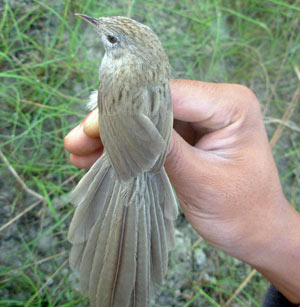
February 4, 2008
Nepali scientists have recorded a new subspecies of bird – Nepal Rufous-vented Prinia – at Koshi Tappu Wildlife Reserve (KTWR) recently.

Photo Courtesy: BCN
According to Bird Conservation Nepal, the bird first recorded by chairperson of Nepal Rare Birds Committee (NRBC) Suchit Basnet and ornithologist Badri Chaudhary on April 1, 2005 at Koshi Tappu.
The birds have now been identified as Rufous-vented Prinia, bringing Nepal’s total bird list to 862 species. Belonging to Prinia burnesii species, the new bird has been named Nepal Rufous-vented Prinia or Prinia burnesii nipalensis scientifically.
Basnet said, “This must have been the most exciting bird record reviewed by the Nepal Rare Birds Committee since its establishment in 2001.”
According to Dr Hem Sagar Baral of BCN, this subspecies of bird is currently found only in Nepal and expressed hope of finding more species of birds in Koshi Tappu, the most popular site for bird watching in winter.
“We must put extra resources for understanding birds and their conservation needs in future,” he said.
Ornithologists call this as a groundbreaking research work and most significant on the taxonomy of Nepal’s birds after the discovery of Nepal Wren Babbler or Pnoepyga immaculata nearly 17 years ago.
Rufous-vented Prinia’s other two species are identified. One Prinia burnesii burnesii is found in Pakistan along the tributaries of Indus River and adjacent Punjab in India, and the other Prinia burnesii cinerascens is found in Assam, India along the Bramhaputra river systems and adjoining states of India and Bangladesh.
The new bird recorded in Koshi Tappu shows somewhat intermediate characters between these two subspecies and appears to form a link between them.
BCN further said the adult of this newly found subspecies has overall olive-grey to light brown plumage. The head and nape are greyer compared to the browner back, wings and tail. In most individuals, there is faint whitish supercilium which reaches behind the eye. The head is densely streaked compared to back and n the back, the streakings are bolder compared to the ones in head. The juveniles are similar to adults but slightly less marked on the head and body. Light rufous under-tail coverts were visible in one young bird caught.
They were located on grassland patches on small islands of the Koshi River but absent in heavily disturbed grasslands adjacent to villages indicating their preference for less disturbed grasslands.
Source: “New species of bird found in Koshi Tappu,” Nepal News.com, Feb 04 08.
About Loren Coleman
Loren Coleman is one of the world’s leading cryptozoologists, some say “the” leading living cryptozoologist. Certainly, he is acknowledged as the current living American researcher and writer who has most popularized cryptozoology in the late 20th and early 21st centuries.
Starting his fieldwork and investigations in 1960, after traveling and trekking extensively in pursuit of cryptozoological mysteries, Coleman began writing to share his experiences in 1969. An honorary member of Ivan T. Sanderson’s Society for the Investigation of the Unexplained in the 1970s, Coleman has been bestowed with similar honorary memberships of the North Idaho College Cryptozoology Club in 1983, and in subsequent years, that of the British Columbia Scientific Cryptozoology Club, CryptoSafari International, and other international organizations. He was also a Life Member and Benefactor of the International Society of Cryptozoology (now-defunct).
Loren Coleman’s daily blog, as a member of the Cryptomundo Team, served as an ongoing avenue of communication for the ever-growing body of cryptozoo news from 2005 through 2013. He returned as an infrequent contributor beginning Halloween week of 2015.
Coleman is the founder in 2003, and current director of the International Cryptozoology Museum in Portland, Maine.
Filed under Breaking News, Cryptotourism, CryptoZoo News, Cryptozoologists, Cryptozoology, New Species